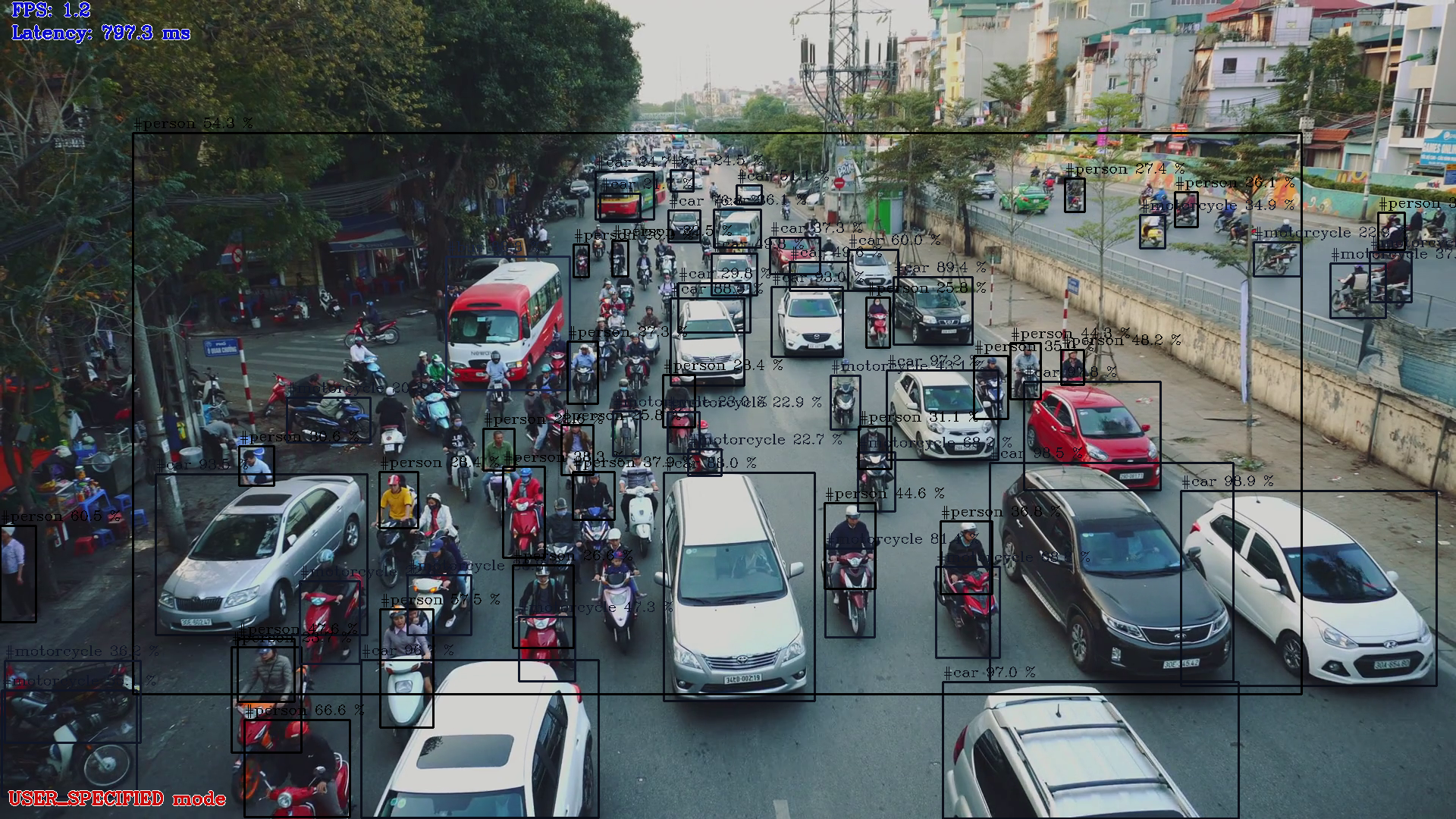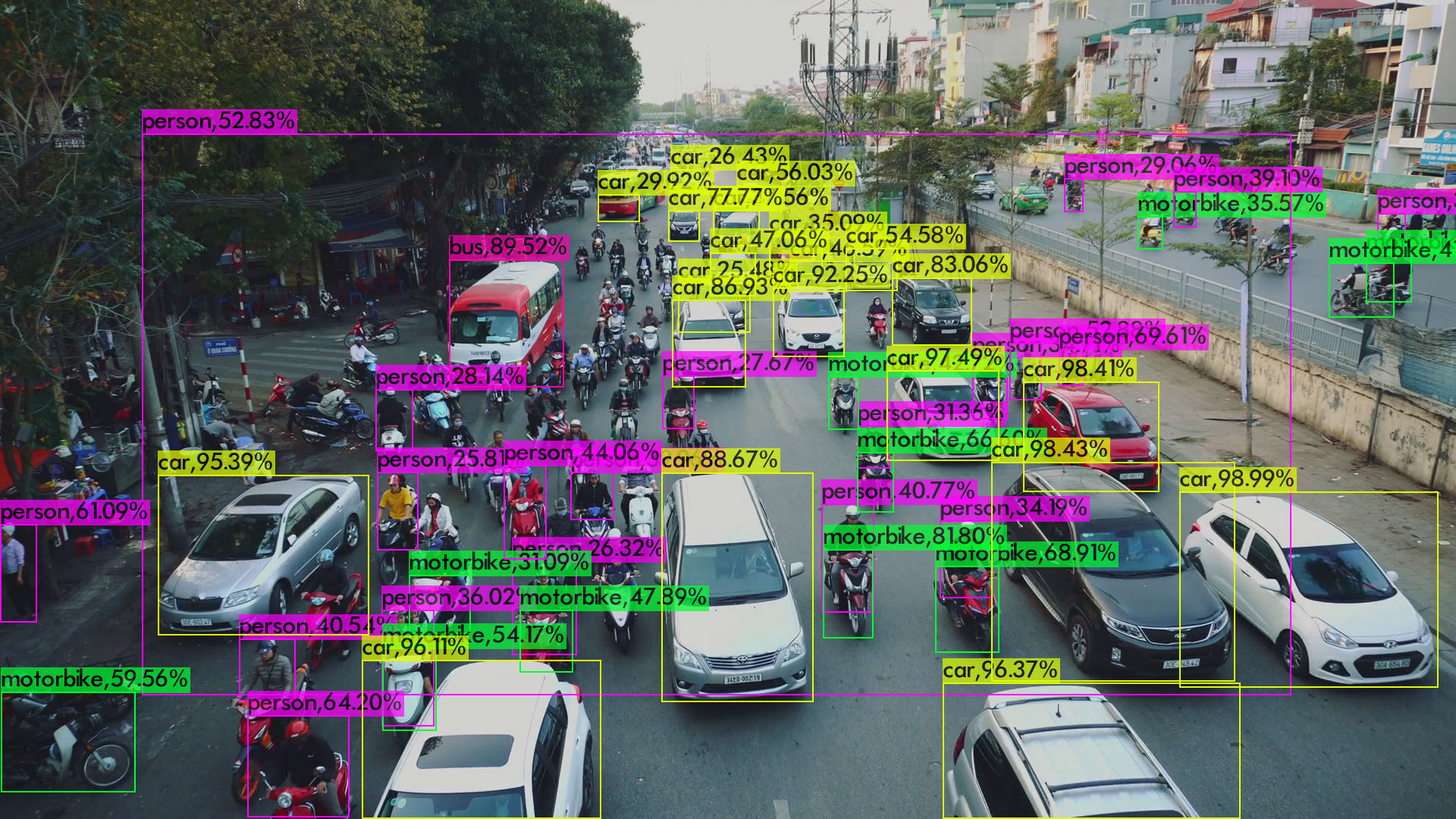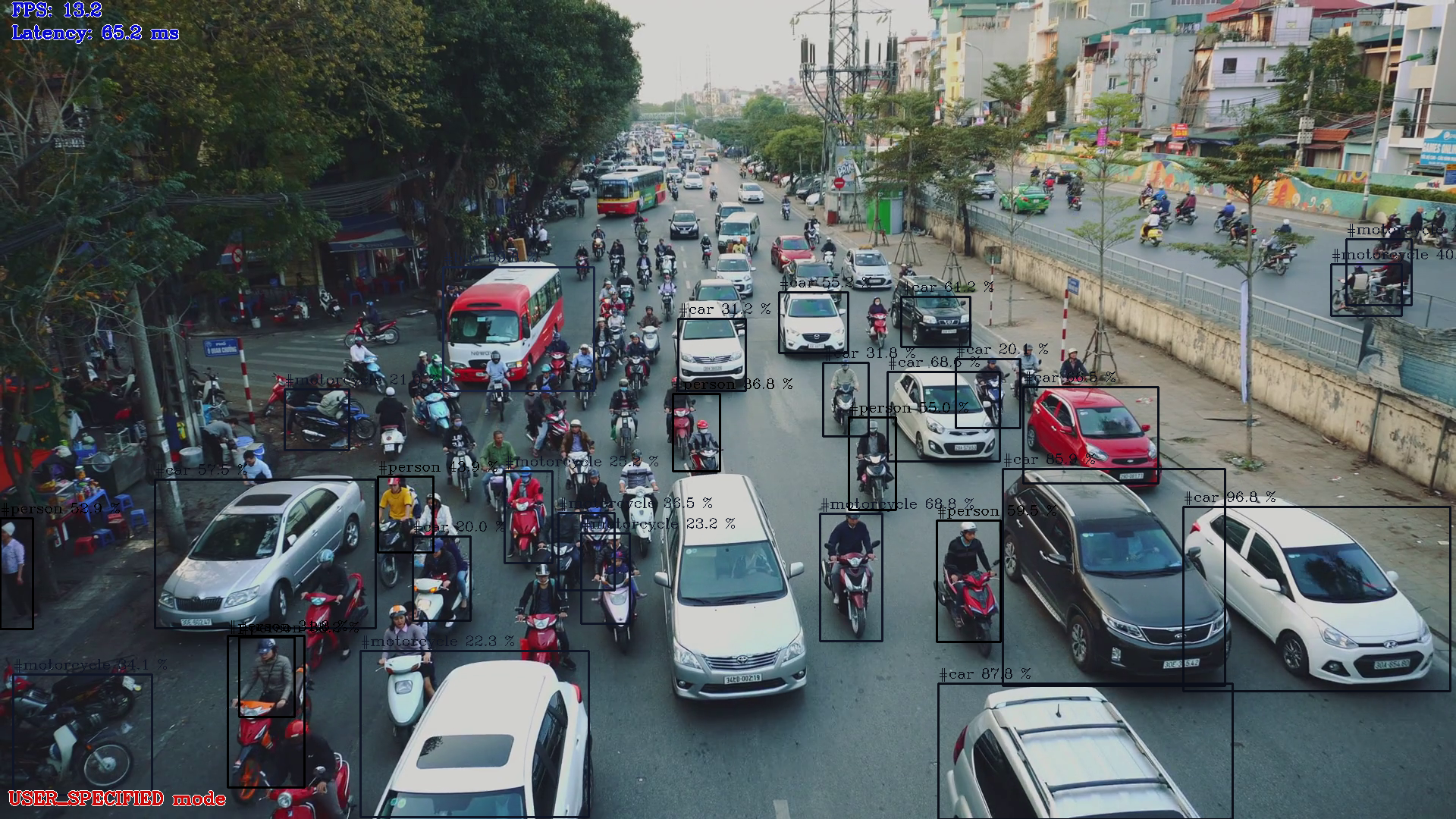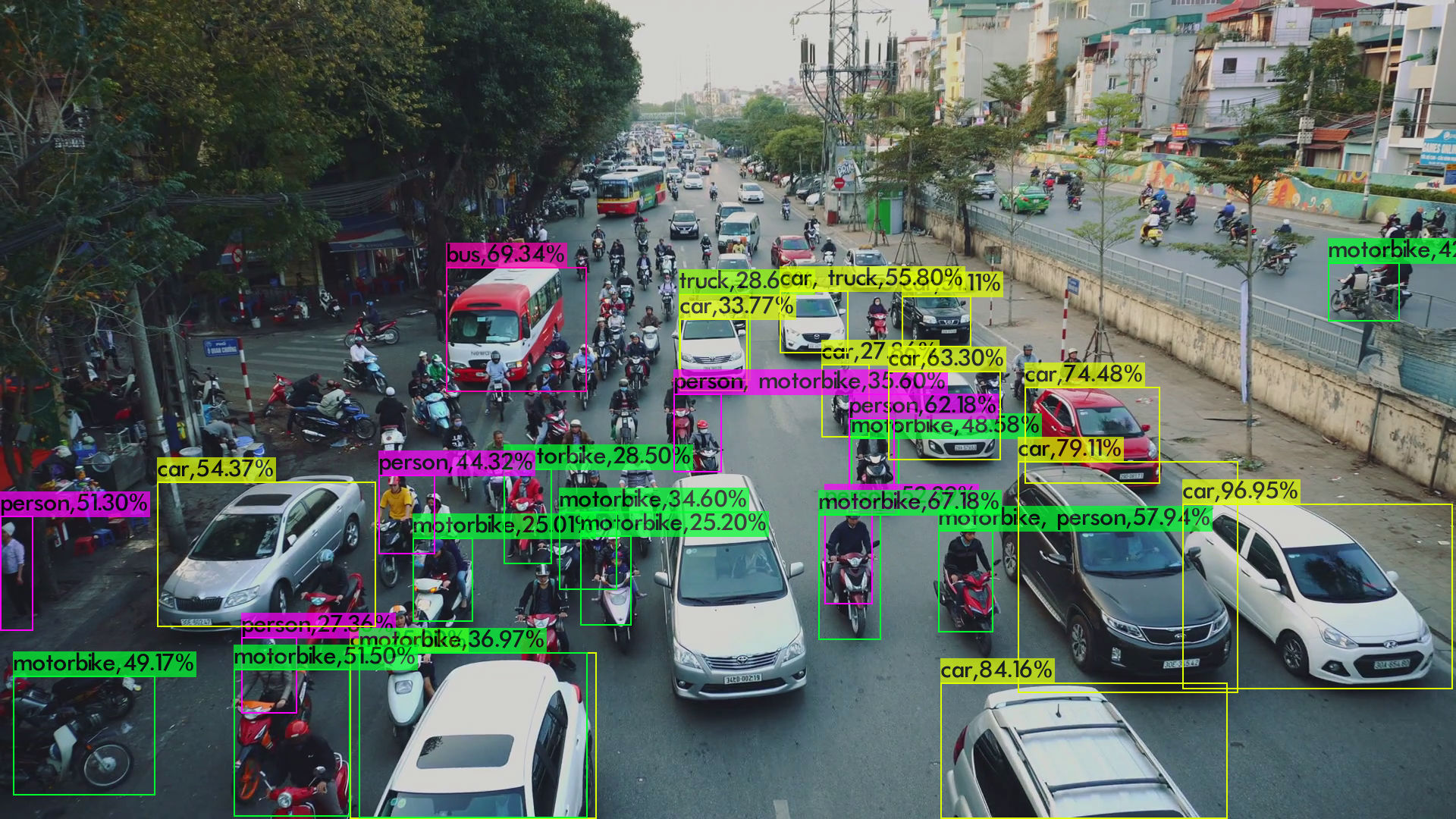This is full implementation of YOLOV4 series in OpenVINO2021.3.
Based on https://github.com/mystic123/tensorflow-yolo-v3
Supported model
- YOLOv4
- YOLOv4-relu
- YOLOv4-tiny
- YOLOv4-tiny-3l
- YOLOv4-csp
- YOLOv4x-mish
Supported device
- Intel CPU
- Intel GPU
- HDDL VPU
- NCS2
- ... ...
Supported model precision
- FP32
- FP16
- INT8 Quantization
Supported inference demo
- Python demo:all models
- C++ demo:YOLOv4,YOLOv4-relu,YOLOv4-tiny,YOLOv4-tiny-3l
-
Pruned-OpenVINO-YOLO:https://github.com/TNTWEN/Pruned-OpenVINO-YOLO
A tutorial on pruning the YOLOv3/v4/v4-tiny/v4-tiny-3l model(find the most compact model structure for the current detection task,greatly compress your model and improve detection FPS)and deploying it in OpenVINO which can even meet the simultaneous inference of multiple video streams. Both Chinese and English versions are available. Welcome to have a try!
-
YOLOv4-tiny-3l:https://github.com/TNTWEN/OpenVINO-YOLOV4/tree/v4-tiny-3l
-
OpenVINO 2021.3 AND OpenVINO2020.4 fully support the project!
-
YOLOv4-csp and YOLOv4x-mish :https://github.com/TNTWEN/OpenVINO-YOLOV4/tree/ScaledYOLOv4
-
Add INT8 Quantization support. Pruned-YOLOv4 series model+ INT8 Quantization will be very friendly to embedded devices
- OpenVINO2021.3 :https://docs.openvinotoolkit.org/latest/index.html or OpenVINO2020.4
- If you want to use yolov4+GPU+FP16,please don't use OpenVINO 2021.1 and OpenVINO2021.2
- Win or Ubuntu
- Python 3.6.5
- Tensorflow 1.15.5 (1.12.0 for OpenVINO2020.4 )
- YOLOV4:https://github.com/AlexeyAB/darknet train your own model
- *Convert YOLOV3/2/1 model :https://docs.openvinotoolkit.org/latest/openvino_docs_MO_DG_prepare_model_convert_model_tf_specific_Convert_YOLO_From_Tensorflow.html
★ This repository provides python inference demo for different OpenVINO version.pythondemo
★ Choose the right demo before you run object_detection_demo_yolov3_async.py
★ You could also use C++ inference demo provided by OpenVINO.
(OpenVINO2021.3 default C++ demo path:C:\Program Files (x86)\Intel\openvino_2021.3.394\deployment_tools\open_model_zoo\demos\multi_channel_object_detection_demo_yolov3\cpp)
download yolov4.weights .
#windows default OpenVINO path
python convert_weights_pb.py --class_names cfg/coco.names --weights_file yolov4.weights --data_format NHWC
"C:\Program Files (x86)\Intel\openvino_2021\bin\setupvars.bat"
python "C:\Program Files (x86)\Intel\openvino_2021.3.394\deployment_tools\model_optimizer\mo.py" --input_model frozen_darknet_yolov4_model.pb --transformations_config yolov4.json --batch 1 --reverse_input_channels
python object_detection_demo_yolov3_async.py -i cam -m frozen_darknet_yolov4_model.xml -d CPU
prepare yolov4.weights .
#windows default OpenVINO path
cd yolov4-relu
python convert_weights_pb.py --class_names cfg/coco.names --weights_file yolov4.weights --data_format NHWC
"C:\Program Files (x86)\Intel\openvino_2021\bin\setupvars.bat"
python "C:\Program Files (x86)\Intel\openvino_2021.3.394\deployment_tools\model_optimizer\mo.py" --input_model frozen_darknet_yolov4_model.pb --transformations_config yolov4.json --batch 1 --reverse_input_channels
python object_detection_demo_yolov3_async.py -i cam -m frozen_darknet_yolov4_model.xml -d CPU
download yolov4-tiny.weights .
#windows default OpenVINO path
python convert_weights_pb.py --class_names cfg/coco.names --weights_file yolov4-tiny.weights --data_format NHWC --tiny
"C:\Program Files (x86)\Intel\openvino_2021\bin\setupvars.bat"
python "C:\Program Files (x86)\Intel\openvino_2021.3.394\deployment_tools\model_optimizer\mo.py" --input_model frozen_darknet_yolov4_model.pb --transformations_config yolo_v4_tiny.json --batch 1 --reverse_input_channels
python object_detection_demo_yolov3_async.py -i cam -m frozen_darknet_yolov4_model.xml -d CPU
Thanks for Jacky's excellent work!
Ref:https://docs.openvinotoolkit.org/latest/pot_README.html
Environment:
- OpenVINO2021.3
- Ubuntu 18.04/20.04 ★
- Intel CPU/GPU
Step 1:Dataset Conversion
we should convert YOLO dataset to OpenVINO supported formats first.
|--annotations
|-- output.json #output of convert.py , COCO-JSON format
|--images
|-- *.jpg #put all the images here
|--labels
|--*.txt #put all the YOLO format .txt labels here
|--classes.txt
we use coco128 for example:
cd INT8
python3 convert.py --root_dir coco128 --save_path output.json
Step 2: Install Accuracy-checker and POT
sudo apt-get install python3 python3-dev python3-setuptools python3-pip
cd /opt/intel/openvino_2021.3.394/deployment_tools/open_model_zoo/tools/accuracy_checker
sudo python3 setup.py install
cd /opt/intel/openvino_2021.3.394/deployment_tools/tools/post_training_optimization_toolkit
sudo python3 setup.py install
Step 3: INT8 Quantization using POT
Prepare your yolo IR model(FP32/FP16) first.
source '/opt/intel/openvino_2021.3.394/bin/setupvars.sh'
pot -c yolov4_416x416_qtz.json --output-dir backup -e
Parameters you need to set in yolov4_416x416_qtz.json:
-
Line 4,5 :Set FP32/FP16 YOLO IR model 's path
"model":"models/yolov4/FP16/frozen_darknet_yolov4_model.xml", "weights":"models/yolov4/FP16/frozen_darknet_yolov4_model.bin" -
Line 29,30 :Set image width and height
"dst_width": 416, "dst_height": 416 -
Line 38: Annotation_file(COCO JSON file)
"annotation_file": "./coco128/annotations/output.json" -
Line 40: Path of images
"data_source": "./coco128/images", -
There are many other quantization strategies to choose from, and the relevant parameters are annotated in yolov4_416x416_qtz.json.Select the strategy you want to replace the default strategy and try by yourself!
Step 4: Test IR model's map using Accuracy-checker
#source '/opt/intel/openvino_2021.3.394/bin/setupvars.sh'
accuracy_check -c yolov4_416x416_coco.yml -td CPU #-td GPU will be faster
Parameters you need to set in yolov4_416x416_qtz.json:
-
Line 5,6 : Set IR model 's path
model: models/yolov4/FP16/frozen_darknet_yolov4_model.xml weights: models/yolov4/FP16/frozen_darknet_yolov4_model.bin -
Line 12: number of classes
classes: 80 -
Line 25: Image size
size: 416 -
Line 38:Annotation_file(COCO JSON file)
annotation_file: ./coco128/annotations/output.json -
Line 39: Path of images
data_source: ./coco128/images



